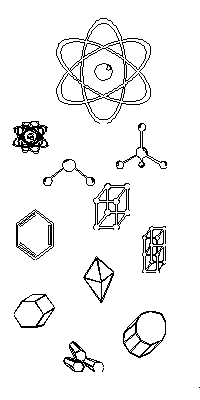
 Among the smallest systems bound by the fundamental forces are the atoms, and from these fundamental entities all of the more complex kinds of material entities derive, using a sort of building-block technique. As the story goes, the engergy of the quantized fields spontaneously produces physical elements--things like quarks, electrons, protons, neutrons, and neutrinos--which interact through their own Fields and bind themselves to each other to produce the various atoms. And these basic structures can themselves combine to produce moleucles, resulting ultimately in the three kinds of material substances: 1) gases—clouds of free-floating atoms or molecules; 2) liquids—compact, loosely bound atoms and molecules; and 3) solids or crystals—atoms or molecules tightly bound in regular lattice-like structures that appear to us as rigid bodies. Among the smallest systems bound by the fundamental forces are the atoms, and from these fundamental entities all of the more complex kinds of material entities derive, using a sort of building-block technique. As the story goes, the engergy of the quantized fields spontaneously produces physical elements--things like quarks, electrons, protons, neutrons, and neutrinos--which interact through their own Fields and bind themselves to each other to produce the various atoms. And these basic structures can themselves combine to produce moleucles, resulting ultimately in the three kinds of material substances: 1) gases—clouds of free-floating atoms or molecules; 2) liquids—compact, loosely bound atoms and molecules; and 3) solids or crystals—atoms or molecules tightly bound in regular lattice-like structures that appear to us as rigid bodies.
 From here, the line of physical systems diverges in two directions: Inorganic substances, and the Organic substance: living matter. Roughly speaking, an organic system is one that self-replicates or reproduces itself, or even—occassionally, through evolution—other kinds. Inorganic systems are physical systems that are not organic. The organic systems are always found associated with—or more properly, living upon—large agglomeratinos of inorganic systems—that is, planets—so that the two branches of complex systems are not separated from each other in the universe, but rather form integrated systems. From here, the line of physical systems diverges in two directions: Inorganic substances, and the Organic substance: living matter. Roughly speaking, an organic system is one that self-replicates or reproduces itself, or even—occassionally, through evolution—other kinds. Inorganic systems are physical systems that are not organic. The organic systems are always found associated with—or more properly, living upon—large agglomeratinos of inorganic systems—that is, planets—so that the two branches of complex systems are not separated from each other in the universe, but rather form integrated systems.
|

